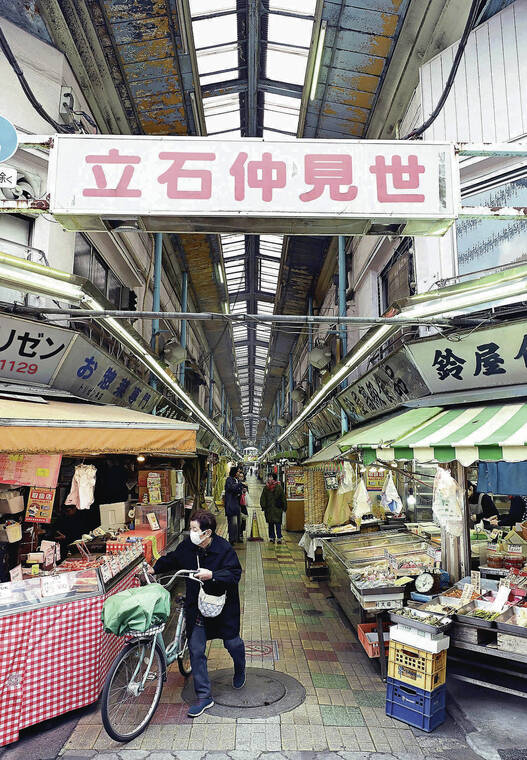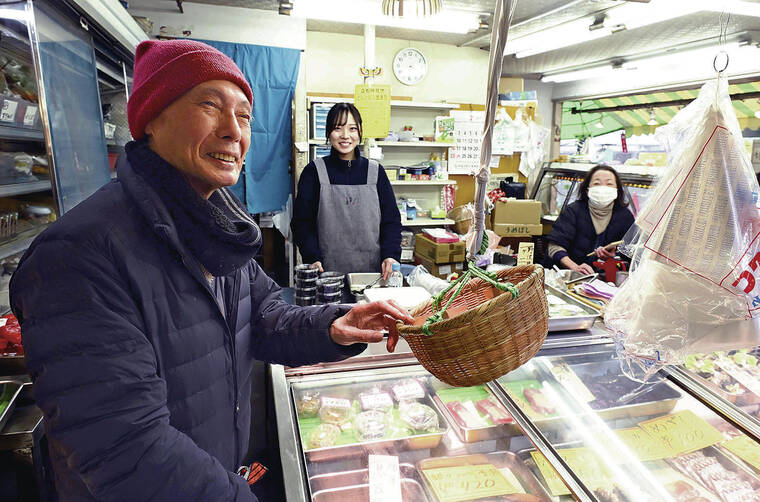
1/2
Swipe or click to see more
JAPAN NEWS
The narrow Tateishi Nakamise shopping street in Tokyo reflects a bygone era.

2/2
Swipe or click to see more
JAPAN NEWS
Kotaro Nagatani, owner of Suzuya Shokuhin, touches a basket as he explains it is used for holding small change.


TOKYO >> Lined with various stores and evoking memories of the Showa era (1926-1989), a shopping street in Tokyo’s Katsushika ward is slated to be demolished in a few years as part of a redevelopment project.
The Tateishi Nakamise shopping street, near the Keisei Tateishi train station, is a friendly local landmark believed to have started as a black market after the end of World War II.
The street is about 160 meters (about 525 feet) long and is lined with some 50 stores, including a long-established delicatessen, a senbei (rice cracker) shop and a clothing store.
When I arrived, I could hear melodies that brought back memories of days gone by.
I started with a visit to the Suzuya Shokuhin delicatessen, next to the street’s green-colored entrance. The store dates back to 1946 when the father of current owner Kotaro Nagatani, 84, began selling leaf vegetables on the black market after he was discharged from the service.
“In the past, we advertised the shopping street by dropping flyers from a plane and riding around on a bicycle with a promotional banner,” Nagatani recalled.
Don’t miss out on what’s happening!
Stay in touch with breaking news, as it happens, conveniently in your email inbox. It’s FREE!
I noted a basket hanging at the storefront.
“It’s a change container. In the old days, every store used it like a cash register,” Nagatani said.
His store’s shelves were lined with colorful ready-to-eat dishes and pickled foods.
I bought cooked uzura mame (pinto beans), which sell for 300 yen (about $2) per 200 grams (about 7 ounces), including tax. The store began cooking them about 70 years ago, when the sugar rationing system ended. The cooked beans were sweet and pleasantly firm.
As I walked further down the street, I saw the yellow, red and green floor tiles lit by the sunlight streaming through the faded windows of the street’s overhead awning.
At the Maruchu Kamaboko store, which sells kamaboko (fish cakes), I found steaming hot oden (stew). (Customers select items in the stew, which are served with the broth.)
Upon hearing my order, owner Yukiko Hidaka, 75, efficiently packaged what I picked.
The cooked daikon (radish, 200 yen including tax) was delicious. The flavor of the broth came through well even in the thick slice of daikon. It satisfied my appetite and my mind.
Until about the end of the Showa era, Tateishi Nakamise was crowded with customers mainly from nearby factories and the ward office. More recently, it has been less busy since large retailers set up shop. Some stores along the arcade have gone out of business.
The area fronting the station comprises old wooden buildings that aren’t up to disaster code. It is undergoing redevelopment, and Tateishi Nakamise is scheduled to be demolished in a few years.
Walking through the street, I could hear the voices of shopkeepers calling out, “Have a nice day.” I saw children run up to store owners who said, “I’ll give you snacks.”
I burned these scenes into my memory, feeling sad that such warm, everyday conversations would soon disappear.

AloJapan.com